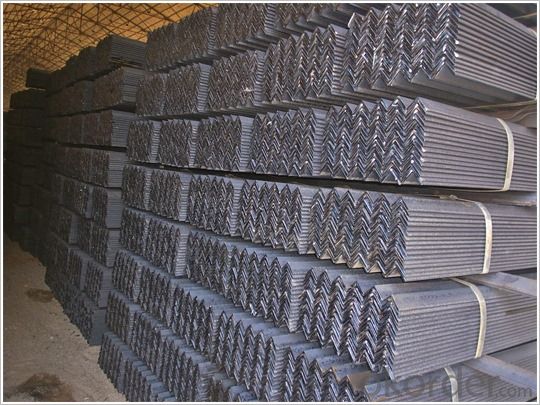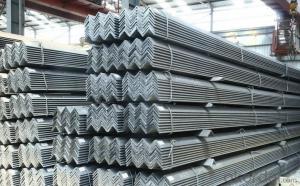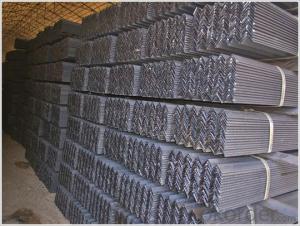Steel Equal Angle with Good Quality 180mm*180mm
- Loading Port:
- Tianjin
- Payment Terms:
- TT OR LC
- Min Order Qty:
- 100 m.t.
- Supply Capability:
- 15000 m.t./month
OKorder Service Pledge
OKorder Financial Service
You Might Also Like
Item specifice
Specifications of Steel Equal Angle with Good Quality 180mm*180mm
1. Invoicing on theoretical weight or actual weight as customer request
2. Length: 6m and 12m
3. Sizes:
| Size(mm) | Mass(kg/m) | Size(mm) | Mass(kg/m) |
| 180*180*12 | 33.159 | 180*180*16 | 43.542 |
| 180*180*14 | 38.383 | 180*180*18 | 48.634 |
Packaging & Delivery of Steel Equal Angle with Good Quality 180mm*180mm:
1. Packing: it is nude packed in bundles by steel wire rod
2. Bundle weight: not more than 3.5MT for bulk vessel; less than 3 MT for container load
3. Marks:
-Color marking: There will be color marking on both end of the bundle for the cargo delivered by bulk vessel. That makes it easily to distinguish at the destination port.
-Tag mark: there will be tag mark tied up on the bundles. The information usually including supplier logo and name, product name, made in China, shipping marks and other information request by the customer.
If loading by container the marking is not needed, but we will prepare it as customer request.
FAQ:
Q1: Why buy Materials & Equipment from OKorder.com?
A1: All products offered byOKorder.com are carefully selected from China's most reliable manufacturing enterprises. Through its ISO certifications, OKorder.com adheres to the highest standards and a commitment to supply chain safety and customer satisfaction.
Q2: How do we guarantee the quality of our products?
A2: We have established an advanced quality management system which conducts strict quality tests at every step, from raw materials to the final product. At the same time, we provide extensive follow-up service assurances as required.
Q3: How soon can we receive the product after purchase?
A3: Within three days of placing an order, we will begin production. The specific shipping date is dependent upon international and government factors, but is typically 1 to 2 months.
Q4: How many tons per bundle?
A4: Around 2-3tons
Q5: How many tons can be loaded into one 20ft container?
A5: Around 23—25tons(6m)
Q6: How many tons can be loaded into one 40ft container?
A6: Around 23—25tons(12m)
Q7: How to avoid the rust after deliver the goods to the loading port?
A7: We will keep the goods at the port covered with water-proof material
Production flow of Steel Equal Angle with Good Quality 180mm*180mm:
Material prepare (billet) —heat up—rough rolling—precision rolling—cooling—packing—storage and transportation
Images of Steel Equal Angle with Good Quality 180mm*180mm:


- Q:What are the different methods for cutting steel angles?
- There are several different methods for cutting steel angles, depending on the specific requirements and the tools available. Some of the most common methods include: 1. Manual cutting: This involves using a handheld hacksaw or a metal cutting bandsaw to cut through the steel angle. It is a labor-intensive method and may not be suitable for large-scale projects or precise cuts. 2. Abrasive cutting: This method uses an abrasive wheel or disc to grind through the steel angle. It is commonly done with an angle grinder or a chop saw. Abrasive cutting is faster than manual cutting and can provide reasonably accurate cuts. 3. Plasma cutting: Plasma cutting involves using a high-temperature plasma arc to melt through the steel angle. It is a versatile method that can cut through thick steel angles quickly and accurately. However, it requires specialized equipment and may not be suitable for small-scale or on-site projects. 4. Laser cutting: Laser cutting uses a high-powered laser beam to melt through the steel angle. It is a precise and efficient method that can produce intricate cuts with minimal heat-affected zones. Laser cutting is commonly used in industrial settings and requires specialized equipment. 5. Waterjet cutting: Waterjet cutting utilizes a high-pressure jet of water mixed with abrasive particles to cut through the steel angle. It is a versatile method that can produce precise cuts without generating heat or causing distortion. Waterjet cutting is commonly used in industries where heat-affected zones and material distortion are a concern. 6. Shearing: Shearing involves using a shear machine to apply a cutting force to the steel angle, causing it to fracture along a predetermined line. It is a fast and efficient method for straight cuts and is commonly used for high-volume production. The choice of cutting method depends on various factors such as the size and thickness of the steel angle, the desired accuracy of the cut, the available equipment, and the project requirements. It is important to consider the specific needs and limitations before selecting the most appropriate cutting method.
- Q:How do you determine the appropriate size of steel angle for a specific application?
- To determine the appropriate size of steel angle for a specific application, factors such as the load it needs to bear, the length of the span, the type of material being supported, and any applicable building codes or regulations should be considered. Structural engineers or professionals with expertise in steel construction can perform calculations and analysis to determine the required size of steel angle based on these factors.
- Q:How do steel angles perform in extreme temperatures?
- Steel angles perform well in extreme temperatures due to their high strength and excellent heat resistance. They retain their structural integrity and do not easily deform or become brittle under extreme heat or cold conditions. This makes steel angles a reliable choice for various applications in industries such as construction, manufacturing, and engineering, where exposure to extreme temperatures is common.
- Q:What are the different types of steel angles used in material handling systems?
- Material handling systems commonly utilize various types of steel angles for structural support and reinforcement. The following are some examples of the different steel angles used in these systems: 1. Equal Leg Angles: These angles possess equal sides and play a crucial role in providing structural support within material handling systems. Their application is typically seen in scenarios where the load is evenly distributed. 2. Unequal Leg Angles: These angles are characterized by unequal sides. They find utility in material handling systems where the load distribution is not uniform. By offering design flexibility, unequal leg angles enable the system to accommodate different load requirements. 3. L-Shaped Angles: L-shaped angles are frequently employed in material handling systems. They serve to form corners or connect various components together. These angles enhance the system's stability and provide reinforcement, particularly at joints and intersections. 4. Slotted Angles: Slotted angles are versatile steel angles that possess a series of holes along their length. These holes facilitate easy adjustment and customization of the material handling system. They are often utilized in the creation of shelving units, workbenches, and other storage solutions. 5. Perforated Angles: Similar to slotted angles, perforated angles feature a pattern of holes across their surface. These holes enhance ventilation and drainage within the material handling system. Common applications for perforated angles include conveyor systems and storage racks where airflow or liquid drainage is essential. 6. Stainless Steel Angles: Stainless steel angles offer high resistance to corrosion and are prevalent in material handling systems operating in harsh environments or requiring hygienic conditions. They excel in applications that prioritize cleanliness, durability, and rust resistance. These examples highlight just a few of the numerous steel angle types employed in material handling systems. The selection of the appropriate angle depends on specific system requirements such as load capacity, structural integrity, and environmental factors. Consulting a professional engineer or designer is crucial in determining the most suitable steel angle for a material handling system.
- Q:What is the maximum cantilever length for a steel angle?
- Various factors, such as material strength, angle dimensions, and load requirements, influence the maximum cantilever length for a steel angle. Steel angles, commonly used as structural elements in construction, can be customized to accommodate different loads based on their size and configuration. In general, the ability of a steel angle to resist bending moments and deflection determines its maximum cantilever length. Bending moments occur when a load is applied to the free end of the cantilever, resulting in angle bending. Deflection refers to the degree of bending or sagging experienced under a specific load. Engineers rely on the moment of inertia, which measures the angle's resistance to bending, and the yield strength of the steel to establish the maximum cantilever length. The moment of inertia is impacted by the angle's dimensions, including flange width, flange thickness, and leg length. To ensure safety and compliance, it is crucial to adhere to project-specific design codes and standards. These guidelines outline the maximum allowable bending stress and deflection limits for steel angles under different loading conditions. To summarize, the maximum cantilever length for a steel angle is determined by factors such as material strength, dimensions, and load requirements. Calculation of the moment of inertia, consideration of yield strength, and compliance with relevant design codes and standards are essential steps in determining this length.
- Q:Can steel angles be used in lighting or electrical fixtures?
- Yes, steel angles can be used in lighting or electrical fixtures. Steel angles are commonly used in construction and fabrication and can provide structural support and stability to lighting or electrical fixtures.
- Q:How do you calculate the weight of a steel angle?
- In order to determine the weight of a steel angle, one must have knowledge of its dimensions and the density of steel. The weight of an object can be determined by using the equation: Weight = Volume × Density For a steel angle, the volume can be obtained by multiplying the cross-sectional area of the angle by its length. The cross-sectional area of the angle can be calculated by multiplying its width by its height. Once the volume is determined, it can be multiplied by the density of steel to find the weight. Let's consider an example where a steel angle has a width of 3 inches, a height of 3 inches, and a length of 6 feet. The density of steel is typically around 7850 kg/m³ or 0.2836 lb/in³. To begin, calculate the cross-sectional area: Area = width × height Area = 3 in × 3 in Area = 9 in² Next, compute the volume: Volume = Area × length Volume = 9 in² × 6 ft × 12 in/ft Volume = 648 in³ Finally, determine the weight: Weight = Volume × Density Weight = 648 in³ × 0.2836 lb/in³ Weight = 183.9828 lb Hence, the weight of the steel angle would be approximately 183.98 pounds.
- Q:How do steel angles perform under high temperatures?
- Steel angles perform well under high temperatures due to their high melting point and excellent heat resistance. Steel is a widely used material in construction and engineering, known for its structural strength and durability. When exposed to high temperatures, steel angles retain their structural integrity and do not deform or weaken easily. This is because steel has a high melting point, typically around 1370 to 1530 degrees Celsius (2500 to 2800 degrees Fahrenheit), which allows it to withstand extreme heat without significant damage. Additionally, steel has excellent heat resistance, meaning it can dissipate heat efficiently and maintain its stability under high thermal loads. This makes steel angles suitable for applications where elevated temperatures are present, such as in industrial furnaces, power plants, or high-temperature environments. However, it is important to note that the specific performance of steel angles under high temperatures may vary depending on the grade and composition of the steel, as well as the duration and intensity of the heat exposure.
- Q:Can steel angles be used for temporary structures or scaffolding?
- Certainly, temporary structures or scaffolding can make use of steel angles. Because of their strength and durability, steel angles find frequent employment in construction endeavors. They are regularly employed to furnish structural support and maintain stability in temporary structures and scaffolding arrangements. Steel angles possess versatility, allowing for effortless welding, bolting, or fastening, leading to the creation of robust and secure temporary structures or scaffolding setups. Furthermore, due to the assortment of sizes and thicknesses available, steel angles prove highly suitable for diverse temporary construction applications.
- Q:What are the different methods of surface powder coating for steel angles?
- There are several methods of surface powder coating for steel angles. These methods are used to apply a protective and decorative layer of powder coating onto the steel surface. 1. Electrostatic Spraying: This is one of the most common methods used for powder coating steel angles. It involves using an electrostatic spray gun to apply the powder coating onto the surface. The powder particles are positively charged and are attracted to the grounded steel angle, resulting in a uniform and even coating. 2. Fluidized Bed: In this method, the steel angles are preheated and then dipped into a bed of fluidized powder particles. The heat from the steel causes the powder particles to melt and adhere to the surface, forming a smooth and durable coating. 3. Powder Coating Booth: This method involves placing the steel angles inside a powder coating booth. The booth is equipped with a powder spray gun that applies a fine mist of powder coating onto the surface. The angles are then cured in an oven to melt and bond the powder particles, creating a strong and long-lasting coating. 4. Electrostatic Fluidized Bed: This method combines the benefits of electrostatic spraying and fluidized bed techniques. The steel angles are preheated and then dipped into a bed of fluidized powder particles. An electrostatic charge is also applied to the powder particles, ensuring a more uniform and controlled coating. 5. Tribocharging: In this method, the powder coating is applied to the steel angles by frictional charging. The powder particles are passed through a tribocharging gun, which imparts a positive charge to the particles. The charged particles are then attracted to the grounded steel angle, resulting in a high-quality and consistent coating. Each of these methods has its own advantages and suitability for specific applications. The choice of the coating method depends on factors such as the desired finish, coating thickness, production volume, and cost considerations.
1. Manufacturer Overview |
|
|---|---|
| Location | |
| Year Established | |
| Annual Output Value | |
| Main Markets | |
| Company Certifications | |
2. Manufacturer Certificates |
|
|---|---|
| a) Certification Name | |
| Range | |
| Reference | |
| Validity Period | |
3. Manufacturer Capability |
|
|---|---|
| a)Trade Capacity | |
| Nearest Port | |
| Export Percentage | |
| No.of Employees in Trade Department | |
| Language Spoken: | |
| b)Factory Information | |
| Factory Size: | |
| No. of Production Lines | |
| Contract Manufacturing | |
| Product Price Range | |
Send your message to us
Steel Equal Angle with Good Quality 180mm*180mm
- Loading Port:
- Tianjin
- Payment Terms:
- TT OR LC
- Min Order Qty:
- 100 m.t.
- Supply Capability:
- 15000 m.t./month
OKorder Service Pledge
OKorder Financial Service
Similar products
New products
Hot products
Related keywords




























